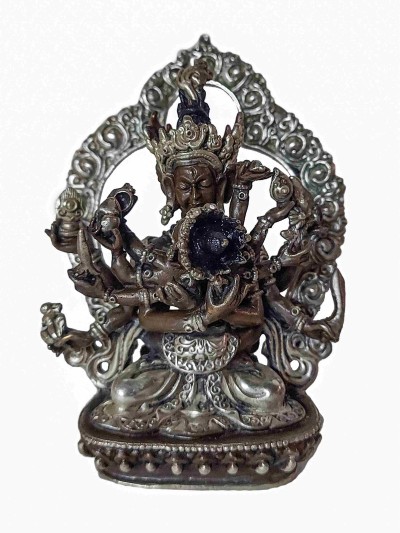Loading Content..

Guhyasamāja is one of the most interesting, complicated and important figures in vajrayana buddhism. It combines various important tathagata Buddhas, (Dhayani Buddhas) into one sclupture. It is perdominantly is call Akshobhayavajara which is the form of Akshobhaya buddha. Guhyasamāja is blue-black in color, a form of Akshobhya, one of the five transcendent lords. Akshobhyavajra holds a vajra and bell (ghanta) in his first two hands, and other hands hold the symbols of the four other transcendent lords, wheel of Vairocana and lotus of Amitabha in his rights, and gem of Ratnasambhava and sword of Amoghasiddhi in his lefts.
It is said that Guhyasamāja Tantra was taught for the first time by the Shakyamuni Buddha himsself in the form of Vajradhara to Indrabhuti the King of Oddiyana
As with most Tantras, there are different traditions and transmissions. Perhaps the oldest surviving lineage is the Jñānapada Tradition , which goes late 8th century. The most important historically is the Noble Tradition which is based on commentaries attributed to Nāgārjuna, Āryadeva and Candrakīrti.
The Guhyasamāja Tantra (Sanskrit; Scripture of the Esoteric Community) is one of the most important scriptures of esoteric Buddhism. In its fullest form, it consists of seventeen chapters, though a separate "explanatory tantra" known as the Appendix Tantra (uttaratantra) is sometimes considered to be its eighteenth chapter. Many scholars believe that the original core of the work consisted of the first twelve chapters, with chapters thirteen to seventeen being added later as explanatory material.
In India, it was classified as a Yoga or Mahāyoga Tantra. In Tibet it is considered an Unexcelled Yoga Tantra (rnal 'byor bla med rgyud). It develops traditions found in earlier scriptures such as the Sarva-tathāgata-tattva-saṃgraha but is focused to a greater extent on the antinomian aspects characteristic of the later Buddhist Tantras. It survives in Sanskrit manuscripts and in Tibetan and Chinese translation.
Loading..
Please wait for the page to fully load for optimal functionality.
Loading Content..